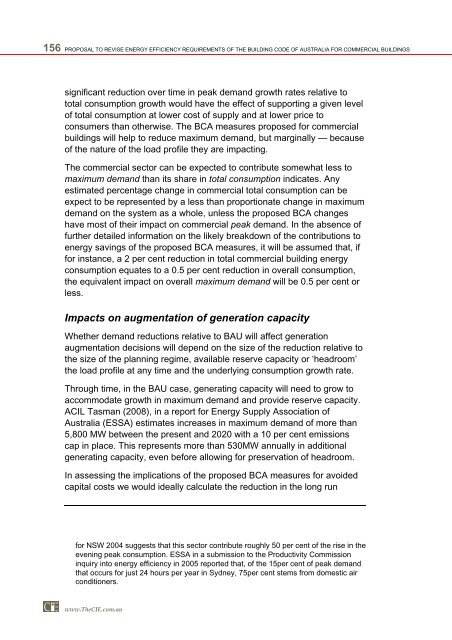PDF | 2 MB - Australian Building Codes Board
PDF | 2 MB - Australian Building Codes Board
PDF | 2 MB - Australian Building Codes Board
Create successful ePaper yourself
Turn your PDF publications into a flip-book with our unique Google optimized e-Paper software.
156 PROPOSAL TO REVISE ENERGY EFFICIENCY REQUIREMENTS OF THE BUILDING CODE OF AUSTRALIA FOR COMMERCIAL BUILDINGS<br />
significant reduction over time in peak demand growth rates relative to<br />
total consumption growth would have the effect of supporting a given level<br />
of total consumption at lower cost of supply and at lower price to<br />
consumers than otherwise. The BCA measures proposed for commercial<br />
buildings will help to reduce maximum demand, but marginally — because<br />
of the nature of the load profile they are impacting.<br />
The commercial sector can be expected to contribute somewhat less to<br />
maximum demand than its share in total consumption indicates. Any<br />
estimated percentage change in commercial total consumption can be<br />
expect to be represented by a less than proportionate change in maximum<br />
demand on the system as a whole, unless the proposed BCA changes<br />
have most of their impact on commercial peak demand. In the absence of<br />
further detailed information on the likely breakdown of the contributions to<br />
energy savings of the proposed BCA measures, it will be assumed that, if<br />
for instance, a 2 per cent reduction in total commercial building energy<br />
consumption equates to a 0.5 per cent reduction in overall consumption,<br />
the equivalent impact on overall maximum demand will be 0.5 per cent or<br />
less.<br />
Impacts on augmentation of generation capacity<br />
Whether demand reductions relative to BAU will affect generation<br />
augmentation decisions will depend on the size of the reduction relative to<br />
the size of the planning regime, available reserve capacity or ‘headroom’<br />
the load profile at any time and the underlying consumption growth rate.<br />
Through time, in the BAU case, generating capacity will need to grow to<br />
accommodate growth in maximum demand and provide reserve capacity.<br />
ACIL Tasman (2008), in a report for Energy Supply Association of<br />
Australia (ESSA) estimates increases in maximum demand of more than<br />
5,800 MW between the present and 2020 with a 10 per cent emissions<br />
cap in place. This represents more than 530MW annually in additional<br />
generating capacity, even before allowing for preservation of headroom.<br />
In assessing the implications of the proposed BCA measures for avoided<br />
capital costs we would ideally calculate the reduction in the long run<br />
for NSW 2004 suggests that this sector contribute roughly 50 per cent of the rise in the<br />
evening peak consumption. ESSA in a submission to the Productivity Commission<br />
inquiry into energy efficiency in 2005 reported that, of the 15per cent of peak demand<br />
that occurs for just 24 hours per year in Sydney, 75per cent stems from domestic air<br />
conditioners.<br />
www.TheCIE.com.au
















